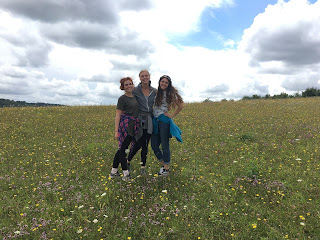The moment I arrived in London and got off at Liverpool
Street, I felt like I was in a different world.
One full of red double decker buses and crowds of men in blue business
suits, and a buzz of city life that I had never experienced before. After managing to grab a taxi, I remember
sitting in the back in marvel of the city as we drove through midday traffic,
passing theatres, extravagant stores, and beautiful old buildings. Arriving at the London Centre, I stopped to
look at the door that I had just seen in pictures, and dreamt about seeing in
person someday. Back then, I had no idea
of the amazing adventures I would have and all the things I would learn here in
the U.K. as a hyper-hip traveling scholar.
Some of my best moments as a true traveling scholar included
when we did the walks, because not only were we finding our way around by
walking, we were learning things about the landmarks as we did so. The Walls of Londonium walk is a great
example. That was just our second day in
London, and I already felt like I was learning so much. On that walk, we were able to follow the
route of the walk pretty well, although we may have taken a few wrong turns along
the way. I felt like a scholar because
if I were just a tourist, I would have most likely just walked right past those
parts of the wall, and not have realized that these were remnants of a wall
built by the Romans in approximately the 3rd century. Similarly, on other walks, we
were able to stop and appreciate history along the way, and see the things that
other people might miss if they weren’t being a scholar. In my future travels, I hope to continue to
cultivate a historical awareness of the places I am going so I don’t miss
anything.
Finally, a third example of hyper-hip traveling scholarship
for me has to do with Dunkirk. If I was
back home, I probably would have seen the movie Dunkirk and thought, “Wow, what
a great movie.” But being here in the
U.K this summer, and learning about past world wars through museums and
historical sites has made me appreciate Dunkirk more than I would have
anticipated. Specifically, first I was
able to learn about Dunkirk at the Imperial War Museum in a way that was interactive
and informative. Then I saw the movie,
which held me suspense the whole time.
And just last week, we went to Dover and toured the underground tunnels,
learning about the event from beginning to end.
The best part was actually being there, and looking out across the ocean
and seeing France on the other side. As my
hyper-hip traveling scholar self, I imagined what it must have been like for
them at Dunkirk, looking over to Dover where we were, praying, hoping, to make
it across. Having the context of the
movie and the history put it all in context for me, and became one of my
favorite traveling scholar moments.
Looking back at all of my experiences on this study abroad,
there are so many times that I felt like a traveling scholar, from seeing
various Shakespeare plays and getting to visit his birthplace, to reading literature like Tintern Abbey, and then getting to visit it and marvel at its beauty. From visiting the Parliament of Scotland, Wales, and the U.K., to touring so
many ancient and beautiful castles and cathedrals. Among all these things, I’ve really enjoyed
doing the walks, visiting the art museums, and learning about Dunkirk. And even further, in
addition to the things I’ve learned, what I will bring home most from this
study abroad are the experiences and friends I’ve made along the way.





























